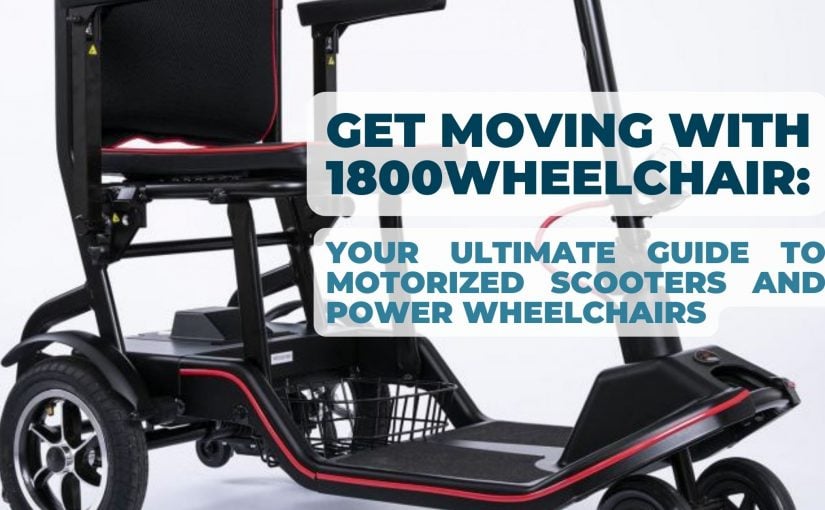To choose the best electric mobility scooter for the elderly or disabled, consider factors such as indoor or outdoor use, the scooter’s fit, controls, seating, portability and storage, maximum recommended incline, and speed. It is important to take into account the individual’s specific needs and preferences when making this decision.

Credit: www.medplushealth.ca
Understanding Electric Mobility Scooters
Electric mobility scooters are a popular choice for the elderly or disabled individuals who require assistance with their mobility. These scooters are designed to provide users with an efficient and comfortable mode of transportation, allowing them to maintain their independence and go about their daily activities with ease.
What Are Electric Mobility Scooters?
Electric mobility scooters are battery-operated devices that are equipped with a seat, handlebars or a tiller, and wheels. They are designed to be used both indoors and outdoors, and offer a range of features and specifications to meet the specific needs of the user.
These scooters are available in various models and sizes, with different weight capacities and maximum speeds. Some models also offer additional features such as headlights, turn signals, adjustable seats, and storage compartments.
Benefits Of Electric Mobility Scooters
- Improved mobility: Electric mobility scooters provide individuals with limited mobility the freedom to move around independently, whether it’s running errands, visiting friends, or simply enjoying the outdoors.
- Comfortable and convenient: These scooters are designed with ergonomic features such as padded seats, adjustable armrests, and easy-to-use controls, ensuring a comfortable and hassle-free riding experience.
- Increased safety: Electric mobility scooters are designed with safety in mind, with features such as anti-tip wheels, rearview mirrors, and bright LED lights to enhance visibility.
- Environmental-friendly: As these scooters are powered by electricity, they are a more eco-friendly alternative to traditional gas-powered vehicles.
- Cost-effective: Electric mobility scooters offer a cost-effective solution for individuals who need assistance with their mobility, as they eliminate the need for expensive transportation services or reliance on others for transportation.
Choosing the best electric mobility scooter for the elderly or disabled requires careful consideration of factors such as the intended use, weight capacity, maneuverability, and battery life. By understanding the different models and their features, individuals can make an informed decision that suits their specific needs and preferences.

Credit: www.1800wheelchair.com
Factors To Consider When Choosing An Electric Mobility Scooter
When considering an electric mobility scooter for the elderly or disabled, it is important to take into account factors such as the scooter’s suitability for indoor or outdoor use, the fit and comfort of the scooter, the control features, seating options, portability and storage capabilities, the maximum recommended incline it can handle, and the speed of the scooter.
These considerations will help ensure the best choice for individual needs.
When it comes to choosing an electric mobility scooter for the elderly or disabled, there are several factors that need to be taken into consideration. These factors will help ensure that the scooter meets the specific needs and requirements of the individual, providing them with optimal comfort, safety, and convenience. Below are some key factors to keep in mind when making your decision:
Indoor Or Outdoor Use
One of the first factors to consider is whether the scooter will primarily be used indoors or outdoors. This will determine the size and maneuverability of the scooter, as well as the type of tires it should have. For indoor use, a compact scooter with a tight turning radius and non-marking tires is ideal. On the other hand, for outdoor use, a scooter with larger wheels and better suspension for uneven terrain is necessary.
Fit Of The Scooter
The fit of the scooter is crucial for the rider’s comfort and safety. It’s important to choose a scooter that can be adjusted to accommodate the individual’s height and weight. Additionally, the seat should be padded and provide adequate support to prevent any discomfort or pain during extended periods of use.
Controls
The type and placement of controls can greatly impact the usability of the scooter, especially for individuals with limited dexterity or strength. Look for scooters with intuitive controls that are easy to operate, such as ergonomic handles or a joystick. Some models even offer customizable controls to cater to individual needs.
Seating
The seating on the scooter should be comfortable and offer proper lumbar support. It’s important to choose a scooter with an adjustable seat that can be positioned at the right height and angle for the individual’s comfort. Additionally, consider features such as armrests and swivel seats for easier transfer in and out of the scooter.
Portability And Storage
Consider the portability and storage options of the scooter, especially if it will be frequently transported or stored in limited spaces. Look for scooters that can be disassembled into smaller, lighter pieces for easy transport or ones that can be folded compactly. Additionally, consider the weight of the scooter and whether it can be easily lifted or maneuvered.
Maximum Recommended Incline
Another important factor to consider is the maximum recommended incline that the scooter can handle. This is especially crucial for individuals who live in hilly areas or need to navigate steep slopes. Ensure that the scooter can handle the incline of the intended routes without compromising stability or safety.
Speed Of The Scooter
The speed of the scooter should be appropriate for the individual’s needs and abilities. While some scooters offer adjustable speed settings, it’s important to choose one that provides a comfortable and safe maximum speed. Consider factors such as the terrain, the intended use, and the individual’s reaction time when determining the right speed.
Choosing The Best Electric Mobility Scooter For The Elderly Or Disabled
When it comes to choosing the best electric mobility scooter for the elderly or disabled, there are several factors to consider. From the type of scooter model to Medicare coverage and reliability, it’s important to ensure that the scooter meets the specific needs and requirements of the user. In this article, we will explore the different types of electric mobility scooters, Medicare coverage for mobility scooters, and the reliability of these scooters.
Types Of Electric Mobility Scooter Models
There are various types of electric mobility scooters available in the market, each designed to cater to different needs and preferences. Some common types include:
- Travel Scooters: These scooters are lightweight and compact, making them ideal for traveling or storage in smaller spaces.
- Indoor Scooters: These scooters are specifically designed for indoor use, with features like tight turning radius and smaller dimensions to navigate through narrow hallways and doorways.
- All-Terrain Scooters: These scooters are robust and equipped with larger wheels and suspension for outdoor use, allowing users to navigate uneven terrains like grass, gravel, and sidewalks.
- Heavy-Duty Scooters: These scooters are designed to accommodate higher weight capacities, providing enhanced stability and durability for users who require extra support.
Medicare Coverage For Mobility Scooters
It’s important to understand the Medicare coverage for mobility scooters if you or your loved one is eligible for the program. Medicare typically covers the cost of a mobility scooter if it is deemed medically necessary and prescribed by a doctor. However, there are certain criteria that need to be met for coverage, such as:
- The user must have a mobility limitation that significantly impacts their ability to perform daily tasks.
- The scooter must be used primarily for indoor or outdoor mobility within the home.
- There must be a doctor’s prescription and a face-to-face examination that verifies the medical necessity of the scooter.
It’s important to consult with a healthcare professional and understand the specific Medicare guidelines and requirements before purchasing a mobility scooter.
Reliability Of Mobility Scooters
When selecting a mobility scooter, reliability is a crucial factor to consider. A reliable scooter ensures safe and efficient transportation for the user. Some key factors to assess the reliability of a mobility scooter include:
- Battery Life: Look for scooters with long-lasting batteries that can provide sufficient range and won’t leave the user stranded.
- Build Quality: Ensure that the scooter is made of durable materials and is well-constructed to withstand regular use.
- Warranty: Check for warranties offered by the manufacturer to address any potential issues or defects.
- User Reviews: Read customer reviews and testimonials to gauge the experiences of other users and their satisfaction with a particular scooter model.
By carefully assessing the reliability of a mobility scooter, you can ensure that you or your loved one will have a dependable mode of transportation for daily mobility needs.
Frequently Asked Questions Of How To Choose The Best Electric Mobility Scooter For The Elderly Or Disabled
Which Electric Scooter Is Best For Senior Citizens?
The best electric scooter for senior citizens is one that is comfortable, reliable, and easy to use. Consider factors like indoor/outdoor use, fit, controls, seating, portability, maximum incline, and speed when choosing the right scooter for seniors.
How Often Will Medicare Pay For A Mobility Scooter?
Medicare will pay for a mobility scooter replacement once every five years, except in limited circumstances. They also cover repairs for rented scooters at no extra charge.
What Are The Most Reliable Mobility Scooters?
The most reliable mobility scooters vary depending on individual needs and preferences. It is important to consider factors such as indoor or outdoor use, fit, controls, seating, portability and storage, maximum recommended incline, and speed of the scooter. Additionally, it is recommended to seek guidance from professional sources or consult with healthcare providers for personalized recommendations.
What Is The Difference Between A Mobility Scooter And An Electric Scooter?
The main difference between a mobility scooter and an electric scooter is the way they are operated. Mobility scooters are controlled using a tiller handle and require both hands to steer, while electric scooters are operated using a joystick mounted on the armrest, requiring less upper body mobility.
Conclusion
Choosing the best electric mobility scooter for the elderly or disabled requires careful consideration of various factors. It is important to assess the scooter’s suitability for indoor or outdoor use, the fit of the scooter, the controls, seating, portability, maximum recommended incline, and speed.
By taking these aspects into account, individuals can find a scooter that meets their specific needs and enhances their comfort and mobility. Remember to consult reputable sources and seek professional advice when making this important decision.
